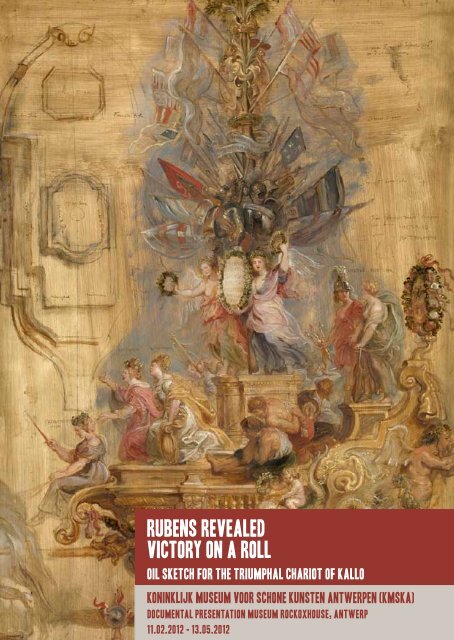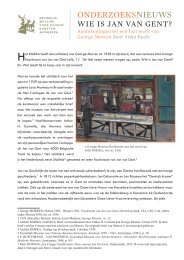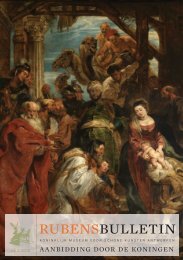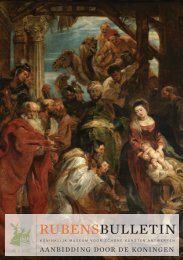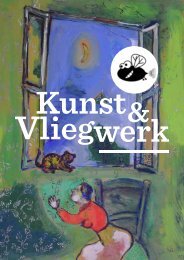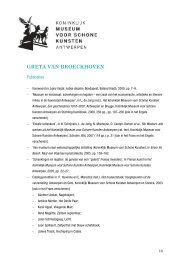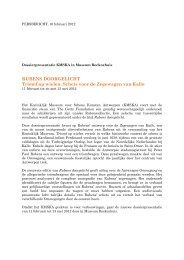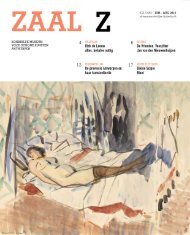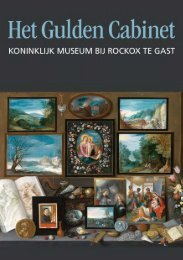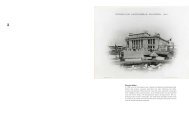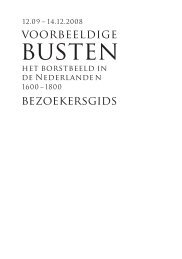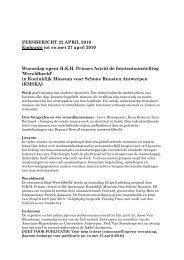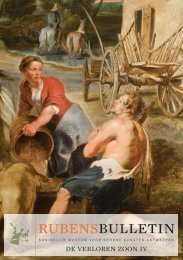visitors' guide to the presentation (PDF, 341 kB) - Koninklijk Museum ...
visitors' guide to the presentation (PDF, 341 kB) - Koninklijk Museum ...
visitors' guide to the presentation (PDF, 341 kB) - Koninklijk Museum ...
You also want an ePaper? Increase the reach of your titles
YUMPU automatically turns print PDFs into web optimized ePapers that Google loves.
RUBENS REVEALED<br />
VICTORY ON A ROLL<br />
Oil Sketch for <strong>the</strong> Triumphal Chariot of Kallo<br />
<strong>Koninklijk</strong> <strong>Museum</strong> voor Schone Kunsten Antwerpen (KMSKA)<br />
DOCUMENTAL PRESENTATION <strong>Museum</strong> Rockoxhouse, Antwerp<br />
11.02.2012 - 13.05.2012
Rubens revealed<br />
Vic<strong>to</strong>ry on a Roll<br />
Oil Sketch for <strong>the</strong> Triumphal Chariot of Kallo<br />
Vic<strong>to</strong>ry on a Roll. Oil Sketch for <strong>the</strong> Triumphal Chariot of Kallo is a<br />
documental <strong>presentation</strong> of <strong>the</strong> Rubens project set up by <strong>the</strong> Antwerp<br />
Royal <strong>Museum</strong> of Fine Arts. This exhibition presents <strong>the</strong> results of a<br />
study in<strong>to</strong> <strong>the</strong> context and significance of Peter Paul Rubens’ oil<br />
sketch The Triumphal Chariot of Kallo, 1638.<br />
The exhibition will be held at <strong>the</strong> Rockox House <strong>Museum</strong> in Antwerp<br />
from 11 February <strong>to</strong> 13 May 2012.<br />
The centrepiece is a design for a triumphal chariot that <strong>the</strong> Antwerp<br />
magistracy commissioned Rubens <strong>to</strong> make, <strong>the</strong> occasion for <strong>the</strong><br />
commission being <strong>the</strong> vic<strong>to</strong>ry of <strong>the</strong> Spanish armies over <strong>the</strong> Dutch<br />
troops (i.e. those of <strong>the</strong> Nor<strong>the</strong>rn Ne<strong>the</strong>rlands) at <strong>the</strong> Battle of Kallo.<br />
The first section of <strong>the</strong> exhibition is devoted <strong>to</strong> his<strong>to</strong>rical prints of <strong>the</strong><br />
battle and <strong>the</strong> vic<strong>to</strong>r, Cardinal-Infante Ferdinand. These prints are a<br />
reminder of one of <strong>the</strong> greatest battles of <strong>the</strong> Eighty Years’ War and<br />
provide <strong>the</strong> his<strong>to</strong>rical context for Rubens’ sketch. As an illustration of<br />
<strong>the</strong> joy that erupted in Antwerp following <strong>the</strong> vic<strong>to</strong>ry, <strong>the</strong> au<strong>the</strong>ntic<br />
version of The Song of Kallo can be heard. The second section of <strong>the</strong><br />
exhibition provides a survey of sixteenth- and seventeenth-century<br />
engravings of triumphal chariots and relates Rubens’ design <strong>to</strong> <strong>the</strong><br />
nor<strong>the</strong>rn pic<strong>to</strong>rial tradition of allegorical triumphal chariots. The<br />
Triumphal Chariot of Kallo was intended as a festive float <strong>to</strong> ride in<br />
<strong>the</strong> Antwerp Ommegang (a procession). Two paintings by Van
Bredael give a detailed picture of a festive seventeenth-century<br />
Ommegang in <strong>the</strong> centre of Antwerp.<br />
A panorama board accompanying Rubens’ oil sketch elucidates <strong>the</strong><br />
iconography of <strong>the</strong> allegorical <strong>presentation</strong>.<br />
There is also an audio-visual <strong>presentation</strong> that details <strong>the</strong> personages<br />
that Rubens has placed in his sketch. The <strong>presentation</strong> also dwells on<br />
<strong>the</strong> pic<strong>to</strong>rial tradition of <strong>the</strong> Antwerp Ommegang chariots. A collection<br />
of scale models of traditional figures in <strong>the</strong> Antwerp Ommegang<br />
can be seen in <strong>the</strong> o<strong>the</strong>r rooms of <strong>the</strong> Rockox House <strong>Museum</strong>.<br />
This visi<strong>to</strong>r’s <strong>guide</strong> makes use of <strong>the</strong> concepts ‘allegory’ and ‘personification’.<br />
‘Allegory’ refers <strong>to</strong> a symbolic depiction in which mythological<br />
figures, gods, goddesses or personifications play a part. ‘Personification’<br />
indicates a figure (generally female) symbolizing an abstract<br />
idea and sometimes recognizable by an attribute. Thus, for example<br />
Vic<strong>to</strong>ria, <strong>the</strong> personification of Vic<strong>to</strong>ry, is portrayed with a laurel<br />
wreath, and Antverpia, <strong>the</strong> city maiden of Antwerp, is recognizable<br />
through her crown in <strong>the</strong> form of turreted city walls, above which two<br />
hands are sometimes depicted.<br />
The Battle of Kallo<br />
In <strong>the</strong> summer of 1638, <strong>the</strong>re was an unusually festive atmosphere in<br />
Antwerp, <strong>the</strong> reason being <strong>the</strong> news that Spanish troops had won a<br />
glorious vic<strong>to</strong>ry over <strong>the</strong> armies of <strong>the</strong> Nor<strong>the</strong>rn Provinces. The<br />
encounter <strong>to</strong>ok place at Kallo on <strong>the</strong> Scheldt, a few kilometres north<br />
of Antwerp. Following <strong>the</strong> triumph, <strong>the</strong> city celebrated. Many inhabitants<br />
set out for Kallo on foot and returned from <strong>the</strong> battlefield with<br />
orange fes<strong>to</strong>ons taken from <strong>the</strong> enemy. The military success gained<br />
three days later at St. Omer by Spanish troops fighting against French<br />
(1)
armies heightened <strong>the</strong> festive joy even fur<strong>the</strong>r. But what, in fact, was<br />
<strong>the</strong> cause of <strong>the</strong> euphoric rejoicing after <strong>the</strong> battle of Kallo?<br />
During <strong>the</strong> sixteenth century, Antwerp had developed <strong>to</strong> become<br />
<strong>the</strong> biggest and richest port of The Low Countries and a centre of<br />
international seaborne trade. During <strong>the</strong> revolt of <strong>the</strong> Nor<strong>the</strong>rn<br />
Ne<strong>the</strong>rlands against Spanish domination – <strong>the</strong> Eighty Years’ War<br />
(1568-1648) – <strong>the</strong> city suffered terribly. It was plundered in 1576 by<br />
mutinous Spanish troops in what became known as <strong>the</strong> ‘Spanish<br />
Fury’, and again in 1583 by <strong>the</strong> French troops of Anjou (<strong>the</strong> ‘French<br />
Fury’); two years later, on <strong>the</strong> orders of <strong>the</strong> Spanish king, it was subdued<br />
by Alexander Farnese (<strong>the</strong> Fall of Antwerp). A consequence of<br />
<strong>the</strong> revolt was that <strong>the</strong> Hollanders and Zeelanders blocked access <strong>to</strong><br />
<strong>the</strong> Scheldt, demanding such high <strong>to</strong>lls that <strong>the</strong> overseas trade fell still.<br />
Commerce in Antwerp was also hit by <strong>the</strong> taxes imposed under<br />
Spanish rule. Thousands of Protestant citizens forsook <strong>the</strong> city, not<br />
wishing <strong>to</strong> be reconciled with <strong>the</strong> Catholic faith. Among those that<br />
left were many merchants, craftsmen and artists, seeking <strong>to</strong> find a<br />
better future elsewhere. The blockade of <strong>the</strong> Scheldt and <strong>the</strong> exodus of<br />
so many citizens led <strong>to</strong> <strong>the</strong> decline of <strong>the</strong> once so flourishing and<br />
wealthy port.<br />
It is this fact of his<strong>to</strong>ry that explains <strong>the</strong> joy at <strong>the</strong> vic<strong>to</strong>ry of Kallo, as<br />
<strong>the</strong> vic<strong>to</strong>ry – ascribed <strong>to</strong> <strong>the</strong> intercession of <strong>the</strong> Holy Virgin and<br />
St. Aloysius Gonzaga – rekindled hope among <strong>the</strong> impoverished<br />
citizenry that <strong>the</strong> lost prosperity would be recovered. At a service in<br />
<strong>the</strong> Antwerp Ca<strong>the</strong>dral of Our Lady, attended by a great multitude of<br />
<strong>the</strong> faithful, a Te Deum was sung in <strong>the</strong> presence of <strong>the</strong> vic<strong>to</strong>r,<br />
Cardinal-Infante Ferdinand.<br />
To mark <strong>the</strong> vic<strong>to</strong>ry, <strong>the</strong> Antwerp magistracy decided <strong>to</strong> add a<br />
triumphal chariot <strong>to</strong> <strong>the</strong> annual Ommegang and commissioned<br />
Rubens <strong>to</strong> prepare a design for it.<br />
(2)
HISTORICAL CONTEXT: THE VICTORY AT KALLO<br />
1<br />
Bonaventura Peeters, Failed Attack on Fort Kallo, 1638, etching,<br />
National Print Collection, Amsterdam.<br />
On 21 June 1638, <strong>the</strong> Spanish armies under <strong>the</strong> command of<br />
Cardinal-Infante Ferdinand of Austria defeated <strong>the</strong> troops of <strong>the</strong><br />
Nor<strong>the</strong>rn Ne<strong>the</strong>rlands (<strong>the</strong> States). This plan of Kallo and its surroundings<br />
offers a view of <strong>the</strong> failed attack on Fort Kallo by <strong>the</strong> States’<br />
troops, commanded by Count Willem of Nassau-Siegen. Inset below<br />
is a map of <strong>the</strong> Kruisdijk.<br />
(3)
2<br />
Stefano della Bella, Siege of St. Omer, 1638, etching, National Print<br />
Collection, Amsterdam.<br />
A few days after <strong>the</strong> triumph at Kallo, <strong>the</strong> Spanish armies defeated <strong>the</strong><br />
French at <strong>the</strong> siege of St. Omer. The <strong>to</strong>wn of St. Omer and <strong>the</strong><br />
surrounding countryside can be seen on this outline map of <strong>the</strong><br />
Flemish and Nor<strong>the</strong>rn-French coast between Gravelines and<br />
Dunkirk.<br />
The map provides a bird’s-eye view of <strong>the</strong> siege of <strong>the</strong> city in 1638. In<br />
<strong>the</strong> right foreground is a group of soldiers and horsemen. To <strong>the</strong> left is<br />
a drapery bearing <strong>the</strong> map legends.<br />
(4)
3<br />
Cornelis Galle <strong>the</strong> Younger, after a design by Theodoor van Thulden,<br />
Ferdinand Receives <strong>the</strong> Sword <strong>to</strong> Fight <strong>the</strong> States at Kallo, (Tabula<br />
summi altaris ecclesiae parochialis in Calloo), 1638, engraving, Print<br />
Collection, Plantin-Moretus <strong>Museum</strong>, Antwerp.<br />
The engraving depicts Cardinal-Infante Ferdinand of Austria, Governor<br />
of <strong>the</strong> Sou<strong>the</strong>rn Ne<strong>the</strong>rlands, kneeling <strong>to</strong> receive <strong>the</strong> sword from<br />
<strong>the</strong> hands of St. Paul, who is shown in <strong>the</strong> heavens in company with<br />
<strong>the</strong> Madonna with <strong>the</strong> Child, St. Peter and angels. The armies of <strong>the</strong><br />
States can be seen in <strong>the</strong> background, fleeing after <strong>the</strong> failed attack on<br />
Fort Kallo. The depiction is an expression of <strong>the</strong> religious perception<br />
ascribing <strong>the</strong> vic<strong>to</strong>ry <strong>to</strong> <strong>the</strong> intercession of <strong>the</strong> Madonna. The engraving<br />
is after an altarpiece by Theodoor van Thulden, which was in <strong>the</strong><br />
Church of SS. Peter and Paul in Kallo, and which was probably<br />
removed during <strong>the</strong> French period.<br />
(5)
4<br />
Theodoor van Thulden, after a design by Peter Paul Rubens, The<br />
Triumph of Ferdinand, engraving, Royal <strong>Museum</strong> of Fine Arts,<br />
Antwerp.<br />
In 1635, three years before <strong>the</strong> Battle of Kallo, Cardinal-Infante<br />
Ferdinand was <strong>the</strong> recipient of a festive welcome in Antwerp, which,<br />
<strong>to</strong> mark his Blijde Intrede (Joyous Entry) in<strong>to</strong> <strong>the</strong> city as new Governor<br />
of <strong>the</strong> Spanish Ne<strong>the</strong>rlands, was abundantly decorated with<br />
triumphal arches designed by Rubens. For <strong>the</strong> centrepiece on <strong>the</strong><br />
reverse of Ferdinand’s triumphal arch erected in <strong>the</strong> Lange Nieuwstraat,<br />
Jan van den Hoecke executed a large-scale picture after a design<br />
by Rubens. The engraving executed by Theodoor van Thulden after<br />
this work was as illustration for <strong>the</strong> commemorative volume Pompa<br />
Introitus Ferdinandi, 1642, written by Gevartius, <strong>the</strong> city clerk of<br />
Antwerp.<br />
The depiction symbolises Ferdinand’s triumphal procession after <strong>the</strong><br />
Battle of Nördlingen on 6 September 1634. We see Ferdinand standing<br />
in a Roman war chariot and being crowned with a laurel leaf by a<br />
figure of Vic<strong>to</strong>ry. In <strong>the</strong> foreground are shackled prisoners of war.<br />
Preceding <strong>the</strong> chariot are warriors with banners and armour taken<br />
from <strong>the</strong> enemy. The figure of Vic<strong>to</strong>ry with laurel wreath, prisoners of<br />
war and captured arms is also used as symbol of triumph in Rubens’<br />
sketch for The Triumphal Chariot of Kallo.<br />
(6)
5<br />
17th-century Matchlock Musket, Vleeshuis <strong>Museum</strong>, Antwerp.<br />
During <strong>the</strong> seventeenth century, firearms like <strong>the</strong> matchlock musket<br />
gained <strong>the</strong> decisive advantage on <strong>the</strong> battlefield. Preparing a matchlock<br />
musket for firing <strong>to</strong>ok a while. Gunpowder and a ball had <strong>to</strong> be<br />
loaded in<strong>to</strong> <strong>the</strong> barrel of <strong>the</strong> musket and rammed down with a rod.<br />
The matchlock refers <strong>to</strong> a glowing length of fuse that, after loading,<br />
was clamped in <strong>the</strong> cock or serpentine (an S-shaped holder). Cocking<br />
<strong>the</strong> trigger brought <strong>the</strong> fuse in<strong>to</strong> contact with <strong>the</strong> gunpowder, <strong>the</strong>reby<br />
triggering ignition and <strong>the</strong> firing of <strong>the</strong> ball. Before aiming and firing,<br />
<strong>the</strong> weapon was set on a fork or mount. The matchlock musket<br />
remained in use until <strong>the</strong> end of <strong>the</strong> seventeenth century.<br />
In order <strong>to</strong> achieve continuous salvo fire during a battle, musketeers,<br />
once <strong>the</strong>y had fired, turned <strong>to</strong> <strong>the</strong> right and moved back through <strong>the</strong><br />
ranks of <strong>the</strong>ir comrades <strong>to</strong> reform at <strong>the</strong> rear. During that countermarch,<br />
<strong>the</strong>y were required <strong>to</strong> perform all reloading procedures, in<br />
order <strong>to</strong> be ready <strong>to</strong> fire again.<br />
(7)
6<br />
Bonaventura Peeters, Failed Attack on Fort Kallo, 1638, etching,<br />
National Print Collection, Amsterdam.<br />
The Failed Attack on Fort Kallo is in fact a news print. An easily reproducible<br />
etching made it possible for <strong>the</strong>re <strong>to</strong> be widespread dissemination<br />
of news about an important political event, such as a battle. This<br />
particular print bears two pages of text, one in Dutch and one in<br />
French, although an example with a German text has also been preserved.<br />
The failed attack by <strong>the</strong> army of <strong>the</strong> States under Count<br />
Willem van Nassau-Siegen is reproduced in detail. We see fleeing<br />
soldiers attempting <strong>to</strong> gain <strong>the</strong> waiting boats; in <strong>the</strong>ir flight, many<br />
combatants drowned in <strong>the</strong> marshy area around Fort Kallo. To <strong>the</strong><br />
right is Kallo’s Church of SS. Peter and Paul.<br />
The text accompanying <strong>the</strong> print relates <strong>the</strong> course of <strong>the</strong> battle and<br />
details <strong>the</strong> war booty. The army of <strong>the</strong> Nor<strong>the</strong>rn Provinces consisted<br />
of sixty-four companies, <strong>to</strong>talling 6 700 men, and a 220-strong<br />
cavalry. 2 500 were killed and 3 600 were taken prisoner. The war<br />
booty consisted of around ninety ships laden with munitions, a<br />
number of artillery pieces, and banners and standards.<br />
Rubens’ sketch for The Triumphal Chariot of Kallo includes a trophy of<br />
war booty consisting of armour and banners.<br />
(8)
7<br />
Commemorative coin marking <strong>the</strong> vic<strong>to</strong>ry at Kallo on 21 June 1638,<br />
1638, copper, struck in Brussels, Mayer van den Bergh <strong>Museum</strong>,<br />
Antwerp.<br />
This copper coin was struck <strong>to</strong> commemorate <strong>the</strong> Spanish successes<br />
at <strong>the</strong> Battle of Kallo. The face shows Philip IV, King of Spain, on<br />
horseback, wearing a hat and holding a sceptre. The depiction on <strong>the</strong><br />
obverse is of a ship threatening <strong>to</strong> capsize in <strong>the</strong> waves, a reference <strong>to</strong><br />
<strong>the</strong> battle, which <strong>to</strong>ok place largely in and around <strong>the</strong> water and<br />
during which many Dutch ships were captured.<br />
The fact that <strong>the</strong> King of Spain himself is depicted serves <strong>to</strong> underline<br />
<strong>the</strong> political importance of <strong>the</strong> vic<strong>to</strong>ry. Philip IV had commissioned<br />
his bro<strong>the</strong>r, Cardinal-Infante Ferdinand, <strong>to</strong> defend <strong>the</strong> city of<br />
Antwerp, so strategically important.<br />
(9)
8<br />
Theodoor van Thulden (attributed <strong>to</strong>), Triumphal Arch of Philip IV,<br />
facade, 17th century, oil on panel, Antwerp Royal <strong>Museum</strong> of Fine<br />
Arts.<br />
This work is a copy of a lost Rubens sketch of <strong>the</strong> Triumphal Arch of<br />
Philip IV, on <strong>the</strong> occasion of <strong>the</strong> State Entry of Cardinal-Infante<br />
Ferdinand of Austria (1635). For <strong>the</strong> new governor’s state entry in<strong>to</strong><br />
Antwerp, <strong>the</strong> city was decorated with temporary triumphal arches<br />
designed by Rubens. The Triumphal Arch of Philip IV, a homage <strong>to</strong> <strong>the</strong><br />
Spanish king, was erected at <strong>the</strong> end of <strong>the</strong> Huidevettersstraat. Theodoor<br />
van Thulden (1606-1669) <strong>to</strong>ok part in <strong>the</strong> work preparing <strong>the</strong><br />
festive decorations for <strong>the</strong> State Entry and based his engravings on<br />
<strong>the</strong>se compositions.<br />
The Triumphal Arch, a wooden construction about 21 meters high,<br />
glorified <strong>the</strong> Habsburg dynasty and illustrated how <strong>the</strong> Ne<strong>the</strong>rlands<br />
came <strong>to</strong> be ruled by King Philip IV, <strong>the</strong> bro<strong>the</strong>r of <strong>the</strong> Cardinal-<br />
Infante. The arch had three passageways, separated by columns and<br />
pilasters set on high bases. The large tableau above <strong>the</strong> central passageway<br />
portrays <strong>the</strong> marriage of Maximilian of Austria and Maria of<br />
Burgundy, daughter and heir of Charles <strong>the</strong> Bold. As a result of this<br />
marriage, <strong>the</strong> Ne<strong>the</strong>rlands passed <strong>to</strong> <strong>the</strong> Habsburgs. The group of<br />
figures crowning <strong>the</strong> whole – <strong>the</strong> supreme Roman god Jupiter with his<br />
wife Juno – emphasises <strong>the</strong> his<strong>to</strong>rical importance of this marriage.<br />
Around <strong>the</strong> central arch are depicted <strong>the</strong> six Habsburg rulers over <strong>the</strong><br />
Ne<strong>the</strong>rlands, and at <strong>the</strong> <strong>to</strong>p, <strong>the</strong> ances<strong>to</strong>rs of Philip IV: Emperor<br />
Maximilian 1, Philip <strong>the</strong> Handsome, Philip II and Emperor Charles<br />
V; below <strong>the</strong> Emperors stand Philip III and Philip IV. The wedding<br />
scene and <strong>the</strong> six portraits were all separate paintings placed in <strong>the</strong><br />
wooden triumphal arch. The his<strong>to</strong>rical piece was painted by Jacob<br />
Jordaens, and <strong>the</strong> six portraits by Cornelis de Vos. The wedding scene<br />
(10)
and five of <strong>the</strong> six portraits have survived, but dispersed across different<br />
collections. The coronation of <strong>the</strong> heavenly pair still forms part of<br />
<strong>the</strong> Antwerp Royal <strong>Museum</strong> of Fine Arts collection.<br />
The inspiration for Rubens’ sketches of both <strong>the</strong> Triumphal Arch of<br />
Philip IV for <strong>the</strong> State Entry and <strong>the</strong> Triumphal Chariot of Kallo were<br />
<strong>the</strong> Roman triumphal processions, of which images from ancient<br />
times remain <strong>to</strong> this day in <strong>the</strong> form of reliefs and cameos (semiprecious<br />
s<strong>to</strong>nes carved in relief). Influenced by Petrarch’s Triumphs,<br />
<strong>the</strong> allegory of <strong>the</strong> triumph <strong>to</strong>ok on renewed significance for sculp<strong>to</strong>rs<br />
and painters from <strong>the</strong> Renaissance on.<br />
(11)
9<br />
Jacob Jordaens, As <strong>the</strong> Old Sing, So <strong>the</strong> Young Pipe, ca. 1640, private<br />
collection, pho<strong>to</strong>.<br />
‘Zoals de ouden zongen, piepen de jongen’ (As <strong>the</strong> Old Sing, So <strong>the</strong><br />
Young Pipe) is a proverb meaning that children follow <strong>the</strong> example of<br />
<strong>the</strong>ir elders. The proverb, written down by Jacob Cats in 1632, was<br />
depicted by Jordaens in various versions. Here we see a jolly company<br />
sitting round a table and singing a song, whose title is legible on <strong>the</strong><br />
page of text.<br />
10<br />
Jacob Jordaens, As <strong>the</strong> Old Sing, So <strong>the</strong> Young Pipe, ca. 1640, private<br />
collection, pho<strong>to</strong> detail.<br />
The title of <strong>the</strong> song, Een Nieu Liedeken van Callo (a new song of<br />
Kallo) is clearly visible in <strong>the</strong> detail magnification. Two o<strong>the</strong>r versions<br />
of this work –in <strong>the</strong> museums of Ottawa and Valenciennes respectively<br />
– likewise refer <strong>to</strong> <strong>the</strong> song about <strong>the</strong> Battle of Kallo.<br />
(12)
11<br />
Text of The Song of Kallo.<br />
The joy at <strong>the</strong> vic<strong>to</strong>ry of Kallo was great and pamphlets (also called ‘fly<br />
sheets’) were used <strong>to</strong> disseminate <strong>the</strong> text of <strong>the</strong> song. An example of<br />
such a pamphlet, one containing two versions of <strong>the</strong> song – namely,<br />
Een nieuw Liedeken van Calloy ende Verbroeck and Een Nieu kluchtigh<br />
Liedeken van den Geusen Haes op uyt Calloy – as well as a woodcut, is<br />
in <strong>the</strong> archives of <strong>the</strong> University of Ghent. It was printed in Antwerp<br />
in 1638.<br />
The text of <strong>the</strong> Nieu kluchtigh liedeken van den Geusen Haes op uyt<br />
Calloy consists of ten couplets and was sung <strong>to</strong> an existing refrain:<br />
Hebbense dat ghedaen doense doense.<br />
The first couplet is as follows:<br />
De Geusen, de Geusen<br />
En die boose Fransen, boose Fransen,<br />
Sy quamen met veel Schepen aen<br />
Om in Calloy te dansen.<br />
Hebbense dat ghedaen doense doense<br />
Hebbense dat ghedaen Geus neef comt aen.<br />
(13)
12<br />
Theodoor van Thulden, after Peter Paul Rubens, The Stage of Mercury,<br />
1639-1641, etching and engraving, Print Collection, Plantin-Moretus<br />
<strong>Museum</strong>, Antwerp.<br />
The Stage of Mercury was displayed on <strong>the</strong> Sint-Jansbrug during <strong>the</strong><br />
Joyous Entry of Cardinal-Infante Ferdinand in<strong>to</strong> Antwerp in 1635. It<br />
symbolised <strong>the</strong> flowering and decline of Antwerp as centre of overseas<br />
commerce. During <strong>the</strong> long-drawn-out war between <strong>the</strong> Nor<strong>the</strong>rn<br />
Provinces and Spain, <strong>the</strong> blockade of <strong>the</strong> river Scheldt led <strong>to</strong> <strong>the</strong><br />
decline of Antwerp’s prosperity.<br />
The central panel depicts Mercury, <strong>the</strong> god of Commerce, quitting<br />
Antwerp. He holds his staff and a moneybag in his upheld hand. It is<br />
clear that he is on <strong>the</strong> point of leaving, albeit that a winged put<strong>to</strong> is<br />
attempting <strong>to</strong> hold him back by clutching at a flap of his cloak. The<br />
scene is set on <strong>the</strong> Scheldt. While Commerce, personified by Mercury,<br />
is leaving <strong>the</strong> Antwerp, <strong>the</strong> river god Scaldis, <strong>the</strong> personification of <strong>the</strong><br />
Scheldt, lies slumbering. The female figure <strong>to</strong> <strong>the</strong> right is <strong>the</strong> city<br />
maiden Antverpia, who personifies Antwerp. On her head, she bears a<br />
city crown in <strong>the</strong> form of turreted city walls. Her posture expresses<br />
despair at her inability <strong>to</strong> prevent <strong>the</strong> god of Commerce departing <strong>the</strong><br />
city. The objects around her are also symbolic of lost overseas trade.<br />
She kneels besides an unused anchor and an upturned boat on which<br />
a sleeping seaman is resting.<br />
The scene on <strong>the</strong> left depicts Abundance and Wealth, and is a reference<br />
<strong>to</strong> Antwerp’s rich past. We see Antverpia accepting <strong>the</strong> riches<br />
from <strong>the</strong> woman beside her, who holds a cornucopia (a horn of plenty)<br />
in her hand. This woman personifies Abundance. In <strong>the</strong> adjoining<br />
niche is <strong>the</strong> allegorical figure of Comus, <strong>the</strong> god of Revelry, so apt in<br />
this scene of prosperity.<br />
(14)
The scene <strong>to</strong> <strong>the</strong> right symbolises Poverty and Decay. As a reference <strong>to</strong><br />
<strong>the</strong> miserable situation now prevailing, <strong>the</strong> personification of Poverty<br />
is depicted as <strong>the</strong> mo<strong>the</strong>r of a poverty-stricken family. In <strong>the</strong> niche <strong>to</strong><br />
<strong>the</strong> side stands Industria. She is <strong>the</strong> daughter of Poverty and refers <strong>to</strong><br />
work in manufacturing textiles and o<strong>the</strong>r goods as a source of income,<br />
<strong>to</strong> which Antwerp turned after <strong>the</strong> loss of commerce.<br />
Depicted above <strong>the</strong> spectacle are <strong>the</strong> sea gods Neptune and Amphitrite.<br />
They are a reference <strong>to</strong> <strong>the</strong> good times when Antwerp had open access<br />
<strong>to</strong> <strong>the</strong> sea.<br />
(15)
ALLEGORICAL TRIUMPHAL ChariotS<br />
13<br />
Hans Guldenmund, after a design by Albrecht Dürer, Triumphal<br />
Chariot of Emperor Maximilian I, 1527-1528 and/or 1545, woodcut on<br />
paper, first and second sheet, National Print Collection, Rijksmuseum,<br />
Amsterdam.<br />
This wood engraving is a copy after Albrecht Dürer’s Great Triumphal<br />
Chariot in Honour of Emperor Maximilian I, <strong>the</strong> complete version of<br />
which consists of eight sheets. The original (1518) was published by<br />
Dürer in 1522, three years after Maximilian’s death.<br />
Dürer designed a triumphal chariot that was <strong>to</strong> be drawn by six pairs<br />
of horses. The emperor’s chariot was accompanied by twenty-two<br />
personifications symbolising his virtues. The first two sheets show <strong>the</strong><br />
section with <strong>the</strong> imperial chariot. Maximilian is dressed in a coronation<br />
cloak, wears an imperial crown on his head and holds a sceptre<br />
and a palm branch in his hands. The o<strong>the</strong>r imperial symbols – <strong>the</strong><br />
sword and <strong>the</strong> orb – rest on a cushion. Vic<strong>to</strong>ria (Vic<strong>to</strong>ry) crowns<br />
Maximilian with a laurel wreath and he is accompanied by <strong>the</strong> Cardinal<br />
Virtues Justitia (Justice), Temperantia (Temperance), Fortitudo<br />
(Fortitude) and Prudentia (Prudence). The chariot is driven by Ratio<br />
(Reason). The triumphal chariot not only refers <strong>to</strong> a military vic<strong>to</strong>ry,<br />
but also ex<strong>to</strong>ls Maximilian’s qualities as ruler.<br />
(16)
14<br />
Wierix ( attributed <strong>to</strong>), The Triumphal Chariot of Peace, 1577, engraving,<br />
National Print Collection, Rijksmuseum, Amsterdam.<br />
During <strong>the</strong> Eighty Years’ War, depiction of such an allegorical triumphal<br />
chariot was a means of symbolising <strong>the</strong> triumph of peace. The<br />
Pacification of Ghent, a treaty concluded after <strong>the</strong> Spanish Fury in<br />
1576, aimed at res<strong>to</strong>ring unity among <strong>the</strong> Seventeen Provinces of<br />
<strong>the</strong> Ne<strong>the</strong>rlands. Underpinning <strong>the</strong> Pacification of Ghent was <strong>the</strong><br />
Perpetual Edict, signed in February 1577 by <strong>the</strong> new governor of<br />
<strong>the</strong> Ne<strong>the</strong>rlands, Don Juan. Wierix’s engraving is an expression of <strong>the</strong><br />
hope for peace that arose after signature of <strong>the</strong> treaty.<br />
The triumphal chariot as symbol of peace is drawn by three donkeys.<br />
Sitting on <strong>the</strong> chariot, which carries <strong>the</strong> coats-of-arms of Philip II,<br />
Don Juan of Austria and <strong>the</strong> city of Antwerp, are <strong>the</strong> personifications<br />
of Caritas (Charity), Pax (Peace) and Foedus (Covenant). Behind <strong>the</strong><br />
chariot follow <strong>the</strong> representatives of <strong>the</strong> States-General and left, kneeling,<br />
<strong>the</strong> maidens of <strong>the</strong> Seventeen Provinces. Livor (Malice) and<br />
Proprium commodum (Selfishness) attempt <strong>to</strong> hinder <strong>the</strong> chariot’s progress;<br />
in <strong>the</strong> background, Discordia (Discord) is throttled in a tugging<br />
contest between <strong>the</strong> powers of Violentia (Violence) and Populus (<strong>the</strong><br />
People).<br />
(17)
15<br />
Pieter van der Borcht, The Sea Chariot of Neptune, 1599, engraving,<br />
Print Collection, Plantin-Moretus <strong>Museum</strong>, Antwerp.<br />
The Sea Chariot of Neptune (Currus Triumphalis Neptuni), depicts a<br />
triumphal chariot with <strong>the</strong> sea gods Neptune and Amphitrite; it was<br />
built in honour of <strong>the</strong> Joyous Entry of <strong>the</strong> Archdukes Albrecht and<br />
Isabella in 1599. In accordance with Greek mythology, Neptune’s<br />
chariot is drawn by two hippocampi, mythological sea-horses with<br />
lower bodies like fish tails; <strong>the</strong> reins are held by two putti seated astride<br />
<strong>the</strong> sea-horses. The chariot is accompanied by mermaids who are<br />
combing <strong>the</strong>ir hair and looking in a mirror. Tri<strong>to</strong>ns, mythological sea<br />
creatures with <strong>the</strong> head and <strong>to</strong>rso of a man and <strong>the</strong> tail of a fish, carry<br />
vic<strong>to</strong>ry banners and blow on a conch horn. Neptune and Amphitrite<br />
are seated on a throne under a baldachin borne by two dolphins.<br />
Dangling from <strong>the</strong> side of <strong>the</strong> baldachin are fish, <strong>the</strong> booty of <strong>the</strong> sea.<br />
The Sea Chariot was a feature of Antwerp’s annual Ommegang from<br />
1599 on. The <strong>the</strong>me of Neptune’s chariot was one that <strong>the</strong> Antwerp<br />
painter Frans Francken <strong>the</strong> Younger (1581-1642) often returned <strong>to</strong>.<br />
(18)
16<br />
Pieter van der Borcht, after a design by Maerten de Vos, Triumphal<br />
Chariot, 1595, copperplate, Antwerp Royal <strong>Museum</strong> of Fine Arts.<br />
Depicted is <strong>the</strong> triumphal chariot of Antverpia, which appeared in <strong>the</strong><br />
Joyous Entry of Archduke Ernest in<strong>to</strong> Antwerp in 1594. It was this<br />
chariot (currus triumphalis) that <strong>the</strong> new governor’s procession<br />
encountered first on its formal entry in<strong>to</strong> <strong>the</strong> city. Seated on <strong>to</strong>p is <strong>the</strong><br />
figure of Antverpia, in her hand a laurel wreath that she offers <strong>to</strong> <strong>the</strong><br />
governor. The welcoming of a new governor had been <strong>the</strong> task of<br />
Antverpia since <strong>the</strong> entry of Prince Philip in 1549. Here, she is accompanied<br />
by a number of allegorical figures. To her right are Religio<br />
(Religion), with book and crucifix, Obedientia (Obedience), with a<br />
silver yoke, and Reverentia (Deference), with a veil. On <strong>the</strong> o<strong>the</strong>r side<br />
are Fidelitas (Loyalty), with a shield bearing <strong>the</strong> depiction of a dog,<br />
Benevolentia (Benevolence), with a heart held by two hands and<br />
within a laurel wreath, and Beneficii recordatio (Reminder of Benefaction).<br />
To <strong>the</strong> front of <strong>the</strong> chariot are two laurel-wrea<strong>the</strong>d figures in<br />
Roman dress, who symbolise <strong>the</strong> city’s guardian deities (Penates<br />
Publici). Above <strong>the</strong>ir wrea<strong>the</strong>d profiles is Antwerp’s emblem, <strong>the</strong><br />
turreted walls with two hands. The personifications on <strong>the</strong> triumphal<br />
chariot are an expression of <strong>the</strong> city’s attitude <strong>to</strong>wards <strong>the</strong> new governor.<br />
Along <strong>the</strong> front of <strong>the</strong> chariot is a text in which Antverpia declares<br />
her confidence in <strong>the</strong> times ahead under Ernest’s governorship.<br />
(19)
17<br />
Elias van den Bossche, Allegory on <strong>the</strong> Truce and <strong>the</strong> Joining of <strong>the</strong><br />
Parties, 1609, engraving, Print Collection, Rijksmuseum, Amsterdam.<br />
This print of a triumphal chariot is an allegory of Peace and was made<br />
on <strong>the</strong> occasion of <strong>the</strong> peace negotiations that in 1609 led <strong>to</strong> <strong>the</strong><br />
Twelve Years’ Truce (1609-1621). Accompanying <strong>the</strong> triumphal chariot<br />
of Pax (Peace) are Justitia (Justice), Misericordia (Clemency) and<br />
Veritas (Truth); in <strong>the</strong> foreground, Mars <strong>the</strong> god of War is led away<br />
shackled.<br />
To <strong>the</strong> left are <strong>the</strong> Archdukes Albrecht and Isabella, and Fa<strong>the</strong>r Jan<br />
Neyen, who represented <strong>the</strong>m at <strong>the</strong> peace talks with <strong>the</strong> Republic of<br />
<strong>the</strong> Seven United Ne<strong>the</strong>rlands. The figures are in <strong>the</strong> company of <strong>the</strong><br />
representatives of <strong>the</strong> States-General. To <strong>the</strong> right, jointly leading <strong>the</strong><br />
procession of <strong>the</strong> maidens of all <strong>the</strong> Seventeen Provinces, are Maurits<br />
of Nassau, Captain-general of <strong>the</strong> republic’s army, and Ambrogio<br />
Spinola, <strong>the</strong> Spanish commander in <strong>the</strong> Sou<strong>the</strong>rn Ne<strong>the</strong>rlands. In <strong>the</strong><br />
background, swords are being reforged in<strong>to</strong> plough-shares. The three<br />
medallions above bear respectively <strong>the</strong> portraits of Spinola, Albrecht<br />
and <strong>the</strong> Count of Bucquoy; <strong>the</strong> two below bear respectively those of<br />
Maurits and Frederik Hendrik. The print bears witness <strong>to</strong> <strong>the</strong> optimism<br />
at <strong>the</strong> beginning of <strong>the</strong> Twelve Years’ Truce at peace being<br />
achieved between <strong>the</strong> parties in <strong>the</strong> Eighty Years’ War.<br />
(20)
18<br />
Rubens Chariot, print, 1840, Print Collection, Plantin-Moretus<br />
<strong>Museum</strong>, Antwerp.<br />
In 1840, Antwerp celebrated <strong>the</strong> two-hundredth anniversary of<br />
<strong>the</strong> death of Peter Paul Rubens (1577-1640). The city was decorated<br />
with triumphal arches, columns and rio<strong>to</strong>us decoration. The festivities<br />
lasted ten days and a clay figure of Rubens was set up, in anticipation<br />
of a bronze one, which was not yet ready. During <strong>the</strong><br />
festivities, an Ommegang was held, featuring <strong>the</strong> chariots of The<br />
Giant, The Giantess, The Whale, The Ship and The Little Boats,<br />
followed by <strong>the</strong> Rubens Car. In <strong>the</strong> Kunst- en Letterblad periodical<br />
of 1840, <strong>the</strong>re is <strong>the</strong> following description: “Daerop volgde de<br />
kunstenaers- of Rubenswagen- waervan de grootsch-heid alle bewondering<br />
afvergt. Hij heeft de gedaante van een schip met eenen grooten<br />
Try<strong>to</strong>n op den steven.” (“After that came <strong>the</strong> Artists’ or Rubens Car,<br />
whose grandeur caught everyone’s admiration. It has <strong>the</strong> appearance<br />
of a ship with a great tri<strong>to</strong>n on <strong>the</strong> stern”). The chariot carried<br />
<strong>the</strong> text “Hulde aen Rubens door de kunstenaers” (“Homage <strong>to</strong><br />
Rubens by <strong>the</strong> artists”).<br />
The Rubens Chariot of 1840 is a replica after Rubens’ sketch for<br />
The Triumphal Chariot of Kallo, 1638, albeit with a few appropriate<br />
changes: for example, <strong>the</strong> prisoners at <strong>the</strong> foot of <strong>the</strong> trophy were<br />
replaced with four artists, and a plain flagpole replaced <strong>the</strong> metreshigh<br />
original trophy.<br />
For <strong>the</strong> Rubens festivities of 1877, plans were drawn up for a<br />
Rubens Chariot designed by <strong>the</strong> painter Hendrik Verbuecken. Its<br />
cost was estimated at eight <strong>to</strong> nine hundred thousand francs. The<br />
nineteenth-century triumphal chariot – not in an optimal state – is<br />
preserved in one of <strong>the</strong> City of Antwerp’s s<strong>to</strong>rerooms. On <strong>the</strong> occasion<br />
of <strong>the</strong> Rubens Year in 1977, <strong>the</strong> chariot underwent major<br />
(21)
es<strong>to</strong>ration, which included replacing decayed sections and employing<br />
polyester for certain figures. During <strong>the</strong> Rubens Exhibition of<br />
1977, <strong>the</strong> chariot was displayed as an eye-catcher in front of <strong>the</strong><br />
Antwerp Royal <strong>Museum</strong> of Fine Arts.<br />
(22)
19<br />
Peter Paul Rubens, The Triumphal Chariot of Kallo, 1638, oil on panel,<br />
Antwerp Royal <strong>Museum</strong> of Fine Arts.<br />
In 1638, Rubens was commissioned by <strong>the</strong> Antwerp magistracy <strong>to</strong><br />
design a triumphal chariot <strong>to</strong> celebrate <strong>the</strong> vic<strong>to</strong>ry at Kallo. His sketch<br />
was based on his knowledge of Classical Antiquity and <strong>the</strong> Renaissance,<br />
and included elements of a Roman triumphal procession, such<br />
as <strong>the</strong> trophy and <strong>the</strong> prisoners of war. In <strong>the</strong> allegorical chariot were<br />
personifications for whom <strong>the</strong>re was renewed interest in <strong>the</strong> Renaissance.<br />
In Rubens’ sketch, we also perceive <strong>the</strong> influence of <strong>the</strong><br />
Antwerp pic<strong>to</strong>rial tradition. The chariot is decorated with sea creatures<br />
that refer <strong>to</strong> Antwerp as a port; true <strong>to</strong> tradition, an important<br />
place is occupied by <strong>the</strong> city maiden Antverpia.<br />
Rubens set <strong>the</strong> allegory on <strong>the</strong> vic<strong>to</strong>ry at Kallo on a triumphal chariot<br />
in <strong>the</strong> shape of a ship, <strong>the</strong> mast being replaced by an enormous trophy;<br />
<strong>the</strong> shape of a ship refers <strong>to</strong> Felicitas or happiness. The military trophy<br />
consists of armour, standards, banners and armorial bearings, taken<br />
as spoils from <strong>the</strong> enemy. Affixed above <strong>the</strong>m are a laurel wreath, flags,<br />
Habsburg-family coats-of-arms, a cardinal’s hat, a golden crown and,<br />
at <strong>the</strong> <strong>to</strong>p, a laurel tree. The text on two scrolls explains <strong>the</strong> origin of<br />
<strong>the</strong> war booty; it reads: ‘DE GALLIS CAPTA FUGATIS’ (captured<br />
from <strong>the</strong> fleeing French) and ‘CAESIS DETRACTA BATAVIS’ (captured<br />
from <strong>the</strong> defeated Hollanders). To <strong>the</strong> side of <strong>the</strong> trophy stand<br />
two Vic<strong>to</strong>ry figures, who symbolise <strong>the</strong> triumph. The renown of <strong>the</strong><br />
vic<strong>to</strong>ry is underlined by two Fama (personifications of Fame) with<br />
trumpets. To <strong>the</strong> right of <strong>the</strong> trophy is a text reading ‘Inde vaenen<br />
vande Trompetten van Fama’, ‘VICTOR IO’ and ‘IO TRIUMPHE’<br />
(‘In <strong>the</strong> banners of <strong>the</strong> trumpets of Fama’, ‘Long live <strong>the</strong> vic<strong>to</strong>r’ and<br />
‘Long live <strong>the</strong> triumph’). It was with <strong>the</strong>se acclamations that, in<br />
(23)
Antiquity, Roman conquerors were hailed during <strong>the</strong>ir triumphal<br />
processions.<br />
Guiding <strong>the</strong> chariot is Providentia Augusta, who is identified by <strong>the</strong><br />
inscription next <strong>to</strong> her head. Providentia stands for Providence or<br />
Foresight and Augusta refers <strong>to</strong> <strong>the</strong> Roman emperor Augustus. She<br />
symbolizes <strong>the</strong> foresight of <strong>the</strong> Spanish king and wears a laurel wreath<br />
as a symbol of vic<strong>to</strong>ry; fur<strong>the</strong>rmore, she is depicted with two faces,<br />
one looking forward <strong>to</strong> <strong>the</strong> future and <strong>the</strong> o<strong>the</strong>r looking back <strong>to</strong> <strong>the</strong><br />
past. She is modelled on Prudentia (Prudence or Wisdom), one of <strong>the</strong><br />
Cardinal Virtues. On <strong>the</strong> ground beside her is a flaming grenade.<br />
Behind her, on a raised platform, kneel Antverpia and Audomarum,<br />
<strong>the</strong> city maidens of Antwerp and St. Omer; <strong>the</strong>ir names appear in <strong>the</strong><br />
inscriptions above <strong>the</strong>ir heads. Both wear a crown in <strong>the</strong> form of<br />
turreted city walls. Antverpia’s crown is decorated with a wreath of<br />
roses and she is dressed in <strong>the</strong> city colours of Antwerp, red and white.<br />
Audomarum, wearing a yellow cloak, rests her hand on a heraldic<br />
shield. The stance and gestures of <strong>the</strong> city maidens appear <strong>to</strong> express<br />
<strong>the</strong>ir joy at <strong>the</strong> vic<strong>to</strong>ry gained.<br />
The personifications of Virtus (Virtue, as well as Valour and Resolve)<br />
and Fortuna (Fortune, as well as Coincidence or Luck) stand at <strong>the</strong><br />
stern of <strong>the</strong> ship. They, <strong>to</strong>o, are connected <strong>to</strong> <strong>the</strong> triumph: Virtus, symbolising<br />
military power and wearing a helmet, is holding a sword and<br />
a thunderbolt; Fortuna is <strong>the</strong> symbol of fortune, of fickle luck that is<br />
sometimes with one and sometimes against, just as <strong>the</strong> wind that<br />
puffs up her garment. With her hand resting on a ship’s rudder, she<br />
likewise represents safe passage. At <strong>the</strong> foot of <strong>the</strong> trophy are three<br />
seated prisoners of war, who represent <strong>the</strong> Hollanders and French<br />
taken prisoner after <strong>the</strong> vic<strong>to</strong>ries at Kallo and St. Omer.<br />
The triumphal chariot is decorated with fes<strong>to</strong>ons and swirling decorations<br />
that end in lobe-like motifs. Sea creatures, such as <strong>the</strong> dolphin<br />
with a put<strong>to</strong> astride its back and <strong>the</strong> tri<strong>to</strong>n blowing his conch shell,<br />
ride <strong>the</strong> waves and appear <strong>to</strong> be guiding <strong>the</strong> ship; <strong>the</strong> reference is <strong>to</strong> <strong>the</strong><br />
(24)
vic<strong>to</strong>ry on and around <strong>the</strong> waters of <strong>the</strong> Scheldt. The shaft of <strong>the</strong><br />
chariot disappears in<strong>to</strong> <strong>the</strong> gaping maw of a fire-spewing sea-dragon.<br />
Placed above <strong>the</strong> ship’s stern is <strong>the</strong> city coat-of-arms of Antwerp, with<br />
<strong>the</strong> double eagle over <strong>the</strong> city walls and <strong>the</strong> outspread hands.<br />
The city magistracy’s commissioning of <strong>the</strong> design for a triumphal<br />
chariot can be seen a form of city propaganda, <strong>the</strong> design being a<br />
<strong>to</strong>ken of loyalty <strong>to</strong> <strong>the</strong> Spanish governor, whose order <strong>to</strong> repel an<br />
attack on Antwerp had had such a successful outcome.<br />
(25)
20<br />
Theodoor van Thulden, after Peter Paul Rubens, Laurea Calloana,<br />
1642, copperplate, in: Gevartius, Pompa Introitus Ferdinandi, Antwerpen<br />
1642, Print Collection, Plantin-Moretus <strong>Museum</strong>, Antwerp.<br />
In 1641, <strong>the</strong> city magistracy of Antwerp decided <strong>to</strong> include a print<br />
after Rubens’ sketch for The Triumphal Chariot of Kallo as an appendix<br />
in <strong>the</strong> richly illustrated memorial book of Cardinal-Infante Ferdinand’s<br />
Joyous Entry in 1635: Gevartius, Pompa Introitus Ferdinandi,<br />
Antwerp 1642. The print, Laurea Calloana, was engraved by Theodoor<br />
van Thulden who also made <strong>the</strong> engravings <strong>to</strong> illustrate <strong>the</strong> rest<br />
of <strong>the</strong> book. Accompanying <strong>the</strong> print in <strong>the</strong> appendix is a text describing<br />
<strong>the</strong> significance of Rubens’ design. The engraving appears <strong>to</strong> be an<br />
exact copy of Rubens’ oil sketch and it is <strong>the</strong>refore highly probable<br />
that <strong>the</strong> actual sketch served as model for Van Thulden. Comparing<br />
<strong>the</strong> engraving and <strong>the</strong> sketch, we see that Van Thulden has added a<br />
pair of horses, has set <strong>the</strong> grenade on <strong>the</strong> pedestal and has introduced<br />
a view of <strong>the</strong> Kallo battlefield. Pompa Introitus Ferdinandi was printed<br />
in Antwerp in 1642.<br />
(26)
THE ANTWERP OMMEGANG<br />
The Ommegang had been an important event in <strong>the</strong> ecclesiastical year<br />
from as early as <strong>the</strong> Middle Ages. The oldest description of <strong>the</strong> annual<br />
procession is found in a document dating from 1324 and held in <strong>the</strong><br />
Antwerp City Archives; it shows that Ommegangen were already<br />
being held in Antwerp at <strong>the</strong> beginning of <strong>the</strong> fourteenth century. In<br />
<strong>the</strong> earliest processions, saints’ relics were carried around <strong>the</strong> church<br />
and through <strong>the</strong> streets. Initially, religious <strong>the</strong>mes <strong>to</strong>ok <strong>the</strong> central<br />
place in <strong>the</strong> Ommegang, but gradually evolved in<strong>to</strong> profane <strong>the</strong>mes.<br />
One example of this is The Whale: originally accompanied by Jonah,<br />
it came later <strong>to</strong> be accompanied by Neptune, god of <strong>the</strong> sea. Ano<strong>the</strong>r<br />
example concerns <strong>the</strong> Biblical <strong>the</strong>me of <strong>the</strong> giant Goliath, which, during<br />
<strong>the</strong> sixteenth century, became transformed in<strong>to</strong> <strong>the</strong> city giant<br />
Druon Antigoon.<br />
(27)
21<br />
Alexander van Bredael, Antwerp Ommegang, 1697, oil on canvas,<br />
Musée de l’Hospice Comtesse, Lille.<br />
Alexander van Bredael (1663-1720) specialised in <strong>the</strong> depiction of<br />
street and market scenes, as well as of religious festivities such as <strong>the</strong><br />
Antwerp Ommegang on <strong>the</strong> fifteenth of August, <strong>the</strong> Feast of The<br />
Assumption. Here, he shows us part of <strong>the</strong> festive Ommegang on <strong>the</strong><br />
Grote Markt, against <strong>the</strong> background of Antwerp’s Town Hall, <strong>the</strong><br />
arrival on <strong>the</strong> Grote Markt appearing <strong>to</strong> have been <strong>the</strong> high point of<br />
<strong>the</strong> procession. Also in <strong>the</strong> procession are richly decorated floats with<br />
colourfully dressed persons. To <strong>the</strong> right is probably <strong>the</strong> City Chariot<br />
with <strong>the</strong> city maidens; <strong>to</strong> <strong>the</strong> front is The Camel, which was originally<br />
a part of <strong>the</strong> Christmas crib tableau, but later came <strong>to</strong> be a separate<br />
feature of <strong>the</strong> festivities. Hell – depicted as a dark monster-head spewing<br />
fire and smoke – is seen <strong>to</strong> <strong>the</strong> left, by <strong>the</strong> wall of <strong>the</strong> Town Hall,<br />
and in <strong>the</strong> centre The Seven Sorrows of Mary.<br />
This and <strong>the</strong> work by van Bredael mentioned below are both clear<br />
evidence that <strong>the</strong> Ommegang in Antwerp was a joyous, high-spirited<br />
festive occasion in which people from all walks of life participated.<br />
Here are musicians, clowns and banner-bearers on horseback; a tent is<br />
set up on <strong>the</strong> square and food is being sold. The spectacle is observed<br />
both from <strong>the</strong> square and from <strong>the</strong> Town Hall and guild halls.<br />
(28)
22<br />
Alexander van Bredael, Traditional Festivity in Antwerp, 1697, oil on<br />
canvas, Musée de l’Hospice Comtesse, Lille.<br />
This section of <strong>the</strong> Ommegang shows Antwerp’s Ca<strong>the</strong>dral of Our<br />
Lady in <strong>the</strong> background. Here, <strong>to</strong>o, young and old are in festive<br />
mood. In <strong>the</strong> centre is The Whale, spouting water and with Neptune<br />
sitting on it, recognisable by <strong>the</strong> trident he is brandishing. The stream<br />
of water from The Whale is causing amused consternation among <strong>the</strong><br />
group of revellers in <strong>the</strong> left foreground. As tradition dictates, <strong>the</strong><br />
great creature is followed by The Small Dolphins. A respectable company<br />
<strong>to</strong> <strong>the</strong> right appear <strong>to</strong> be interested in <strong>the</strong> wares of hawker. To <strong>the</strong><br />
left is <strong>the</strong> triumphal chariot of Apollo and <strong>the</strong> Muses; behind The<br />
Whale is The Giant. Fur<strong>the</strong>r <strong>to</strong> <strong>the</strong> right is one of The Little Boats<br />
with, nearby, The Elephant carrying Fortuna on its back. Wholly <strong>to</strong><br />
<strong>the</strong> right is The Great Ship, <strong>the</strong> vessel of <strong>the</strong> merchants’ guild, with<br />
sails full and flags fluttering, manned by sailors and set on a chariot on<br />
which <strong>the</strong> waves of <strong>the</strong> sea have been depicted.<br />
(29)
23<br />
Ordre van den Ommeganck, manuscript dating probably from <strong>the</strong> late<br />
seventeenth century and setting out <strong>the</strong> scenography for <strong>the</strong> <strong>presentation</strong><br />
of <strong>the</strong> Ommegang on <strong>the</strong> Grote Markt, Antwerp City Archives.<br />
A seventeenth-century manuscript entitled Ordre van den Ommeganck<br />
(Order of <strong>the</strong> Ommegang) in <strong>the</strong> Antwerp City Archives gives a<br />
detailed description of <strong>the</strong> organisation and execution of <strong>the</strong> festive<br />
Ommegang on <strong>the</strong> Grote Markt. The duration of <strong>the</strong> event is given<br />
(“ten hours precisely”), as is <strong>the</strong> distance between <strong>the</strong> Ommegang<br />
chariots (“about fifty paces”). Stated, <strong>to</strong>o, is <strong>the</strong> place of <strong>the</strong> chariots in<br />
<strong>the</strong> procession and <strong>the</strong> sequence of <strong>the</strong> route through <strong>the</strong> streets and<br />
over <strong>the</strong> market square. The musicians with cymbals and trumpets are<br />
<strong>to</strong> lead <strong>the</strong> way, followed by The Great Ship, The Little Boats, The<br />
Whale, The Small Dolphins and <strong>the</strong> Sea Chariot. Horn players are <strong>to</strong><br />
accompany The Maiden’s Chariot, St. Michael’s Chariot and The<br />
Mount Parnassus, and <strong>to</strong> bring up <strong>the</strong> rear of <strong>the</strong> festive parade are<br />
The Giant, The Lion, The Small Giants and The Elephant. The<br />
Ommegang was well organised. A section of <strong>the</strong> procession was <strong>to</strong> wait<br />
in <strong>the</strong> Hooghstraat while <strong>the</strong> cavalcade on <strong>the</strong> Grote Markt was<br />
directed by aen-lijders (stewards), who gave instructions <strong>to</strong> <strong>the</strong> musicians<br />
and chariots: certain chariots were <strong>to</strong> circle round, o<strong>the</strong>rs <strong>to</strong><br />
remain stationary or <strong>to</strong> manoeuvre in a complex pattern over <strong>the</strong><br />
market square (“laverende door malkanderen” – ‘navigating a passage<br />
between <strong>the</strong> o<strong>the</strong>rs’). The Mount Parnassus was equipped with a<br />
stream of water, and The Whale spouting its water must have been a<br />
sensational sight, <strong>to</strong>o. The margin of <strong>the</strong> document contains instructions<br />
about <strong>the</strong> organisation for <strong>the</strong> water supply: “Nota <strong>to</strong>bben te<br />
stellen op de plette vant stadhuijs” (‘Don’t forget <strong>to</strong> put tubs on <strong>the</strong><br />
Town Hall steps’).<br />
(30)
Scale models of Ommegang figures<br />
As part of <strong>the</strong> exhibition Triumph on Wheels, various scale models<br />
(bozzetti) of Antwerp Ommegang figures are <strong>to</strong> be seen in <strong>the</strong> o<strong>the</strong>r<br />
rooms of <strong>the</strong> Rockox House <strong>Museum</strong>. A few of <strong>the</strong>m are signed<br />
‘Ant. Hoefnaegels 1916’. The models were put on show in 1916 and<br />
1936 at <strong>the</strong> folklore exhibitions Ons Volksleven. The 1936 exhibition<br />
was organised by <strong>the</strong> <strong>Koninklijk</strong> Kunstverbond (Royal Art Association)<br />
in <strong>the</strong> Arenbergstraat, Antwerp.<br />
Audio-visual <strong>presentation</strong> Triumph on Wheels<br />
The Antwerp Ommegang is a procession with a centuries-old tradition.<br />
The audio-visual <strong>presentation</strong> at <strong>the</strong> exhibition shows Ommegang<br />
figures throughout <strong>the</strong> ages; it can be seen in <strong>the</strong> museum’s<br />
Projection Room. It also shows detailed images of Rubens’ oil sketch<br />
The Triumphal Chariot of Kallo.<br />
Visi<strong>to</strong>rs <strong>to</strong> <strong>the</strong> exhibition are invited <strong>to</strong> make <strong>the</strong>ir circuit via <strong>the</strong><br />
Ommegang figures and <strong>the</strong>n take in <strong>the</strong> audio-visual <strong>presentation</strong>.<br />
(31)
Practical details<br />
From 11 February <strong>to</strong> 13 May 2012<br />
Rockox House <strong>Museum</strong>, Keizerstraat 12, 2000 Antwerp<br />
Open Tuesday <strong>to</strong> Sunday, 10 a.m. <strong>to</strong> 5 p.m.<br />
Closed Mondays except Easter Monday, 9 April 2011<br />
The museum is accessible by wheel chair.<br />
Prices<br />
Individual visi<strong>to</strong>rs<br />
2.50 euros<br />
Groups of 15 persons or more (per person): 1.25 euros<br />
OKV members museum card<br />
1.25 euros<br />
19-26 years of age 1.25 euros<br />
Over 60 and Under 19<br />
free of charge<br />
Friends of <strong>the</strong> KMSKA and employees free of charge<br />
KBC cus<strong>to</strong>mers and KBC employees free of charge<br />
School and college groups<br />
free of charge<br />
VMV and ICOM members<br />
free of charge<br />
Disabled persons<br />
free of charge<br />
Job-seekers<br />
free of charge<br />
Entrance <strong>to</strong> <strong>the</strong> museum is free for all on <strong>the</strong> last Wednesday of every<br />
month.<br />
Guided <strong>to</strong>urs for groups<br />
Group visits accompanied by an authorised <strong>guide</strong> are possible.<br />
Reservations should be made with <strong>the</strong> City of Antwerp Tourism<br />
Department,<br />
Tour Guides Service,<br />
Grote Markt 15,<br />
2000 Antwerp,<br />
tel. 03 232 01 03 or 03 338 95 30.
Colophon<br />
Exhibition<br />
Organisation: The Royal <strong>Museum</strong> of Fine Arts in Antwerp in<br />
co-operation with <strong>the</strong> Rockox House <strong>Museum</strong><br />
Cura<strong>to</strong>rs: Ank Adriaans and Valérie Herremans<br />
Co-ordination: Christine Van Mulders and Hildegard Van de Velde<br />
Audiovisual <strong>presentation</strong><br />
Text: Ank Adriaans<br />
Pho<strong>to</strong>s: Adri Verburg and Marie Geraerts<br />
Voice: Dierdre Timp<br />
Recording voice: Peeters Productions NV<br />
Production: Adri Verburg<br />
Visi<strong>to</strong>rs’ Guide<br />
Text: Ank Adriaans<br />
Translation: KBC Language Services<br />
Design: Luc Geyskens<br />
Print coordination: Eddy Moyaers<br />
Illustration cover:<br />
Peter Paul Rubens, The Triumphal Chariot of Kallo<br />
KMSKA © Lukas – Art in Flanders


